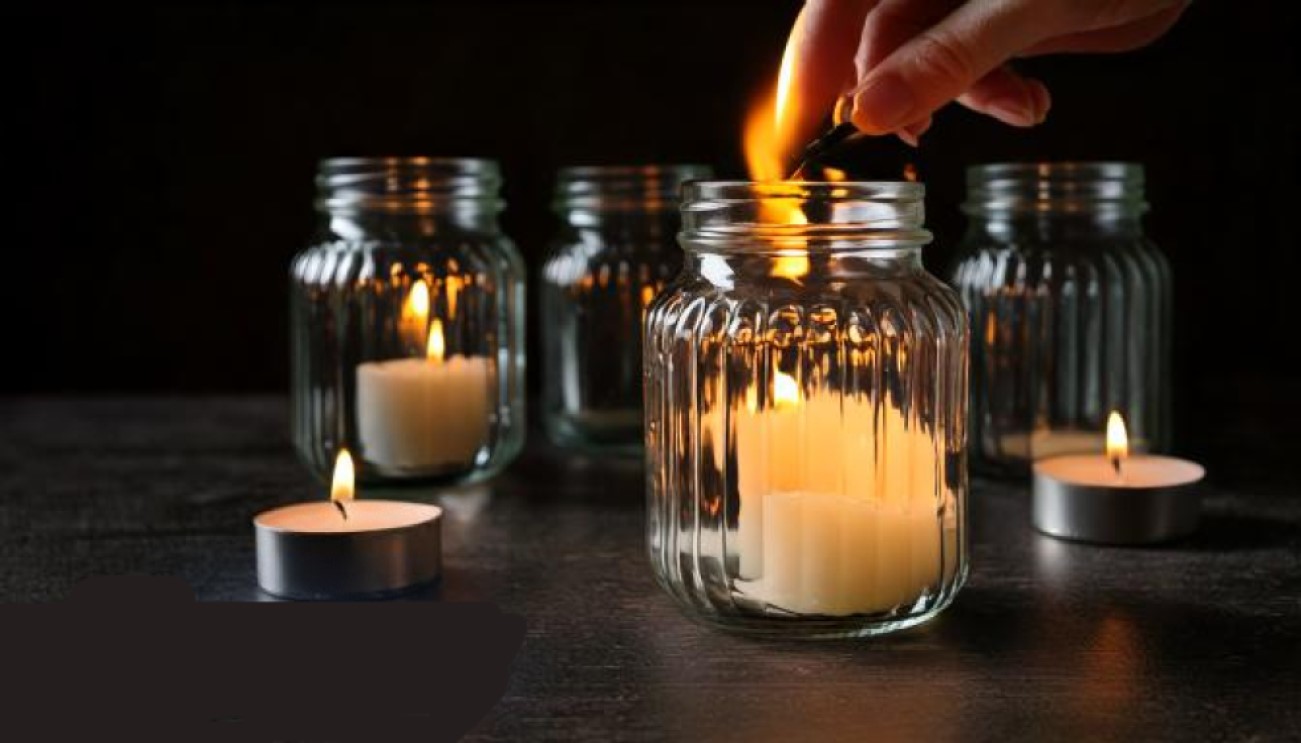
Lighting a candle gives warmth and coziness to any room. But left candle burning in glass jar might lead to unsafe conditions. Many people ask if it’s okay to let a candle burn overnight. They wonder what could happen if a left candle burning at home.
It’s important to know what to do with candle in glass jar left burning. This article looks at the dangers of leaving candles lit. It tells you steps to take if you find a candle left burning. It shows safe ways to put out candles. It also gives tips to prevent this from happening again. The article suggests safer options instead of regular candles. And it explains how to deal with any issues caused by letting a candle burn all night.
Understanding the Risks of Unattended Candles
Many homeowners forget or neglect left candle burning in glass jar. These unattended flames jeopardize safety, unaware of hazardous risks. Examine the possible dangers from letting candles burn.
Fire Hazards
The gravest peril of unattended left candle burning in glass jar. Candles are exposed flames which, if unmonitored, rapidly become fire hazards. According to fire department data, an average 5,910 home structure fires started by candles occur yearly in the U.S. Resulting in 74 civilian deaths and 558 civilian injuries annually, on average.
A leading cause is placing flammable objects too close to lit candles. Furniture, mattresses, bedding, curtains, decorations, paper, clothing – half of candle fires start when these catch fire near candles. Safety requires at least a 12-inch distance between burning candles and anything flammable.
Property Damage
Inadvertently left candle burning in glass jar overnight risks devastating property damage. Fires alone cause roughly $257 million in direct yearly property losses. Even without fire, burning candles damage property via soot – airborne carbon residue staining walls, carpets, possessions.
Sometimes, candle soot leaves a horrific mess. You scrub, but it won’t budge. Homeowners insurance may not cover that destruction, costing you big bucks.
Health Concerns
Beyond fire hazards, burning candles pose health issues too. Scented paraffin wax candles release volatile organic compounds like toluene into the air. Inhaling high toluene levels can affect your nervous system, lungs, and developing brain.
After candle exposure, some experience vertigo, headaches, breathing troubles, watery eyes, sneezing, or stuffy noses. Those with asthma might react worse to burning candles.
Never left candle burning in glass jar alone, especially overnight. Snuff flames before exiting rooms or sleeping. If health worries you, opt for soy or beeswax candles with natural scents over synthetic ones.
Understanding risks lets you safely enjoy candles at home without endangering loved ones or property.
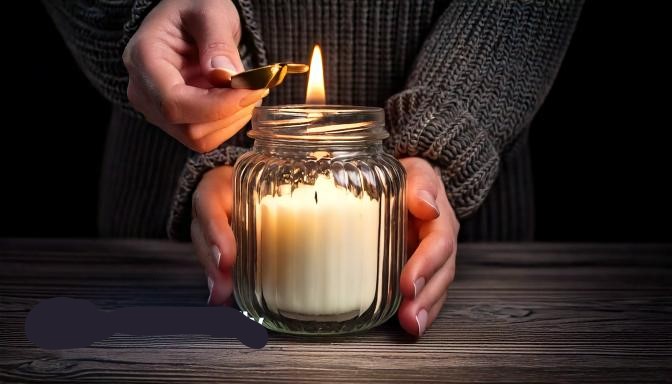
Immediate Action Plan for Left Candle Burning in Glass Jar
Discovering a left candle burning in glass jar can feel alarming, yet it’s vital to stay composed and act swiftly. This passage outlines safe, effective measures to handle this circumstance.
Evaluating the Situation
Upon realizing they accidentally left candle burning all night at home, one should carefully assess the situation. If feasible, visually inspect the area from a secure distance. Verify if the candle remains contained within the glass jar and ensure no nearby objects have ignited. Remember, candles are open flames and potential fire hazards if unattended.
Should the candle burn normally inside the glass jar, with no other objects ablaze, the urgency may be lower. However, an unusually high or frequently flickering flame could indicate an issue requiring immediate attention.
Seeking Assistance
Notice any fire spreading beyond the candle or an unsafe environment? Then promptly contact emergency services. Fires can rapidly escalate, so professional firefighters are best equipped to handle such situations.
For less urgent scenarios where the candle remains contained but help is needed, reaching out to neighbors or friends to check the situation may prove helpful. Especially crucial if one is away from home and realizes left candle burning in glass jar.
Remote Monitoring Options
Those worrying about leaving candles lit can find peace with modern solutions. Home devices and remote systems allow oversight. Check out these possibilities:
- Smart smoke detectors send phone alerts if detecting smoke, even when you’re away.
- Cameras inside let you visually confirm the candle’s state and surroundings.
- While unsuited for regular candles, smart plugs can automatically shut off electric wax warmers or flameless options after set durations.
- Battery-powered flameless candles, some with timers and remote control, mimic ambiance without fire hazard.
Employing these technologies reduces accidentally left candle burning all night risks, granting greater home control remotely.
Remember, these tools aid but don’t replace caution. Extinguishing candles before leaving a room or sleeping is safest. Keep them away from kids, pets, and ensure at least four feet from flammable items.
Safe Candle Extinguishing Methods
When you need to safely extinguish left candle burning in glass jar, some techniques work better than others. Using the right methods helps put out the flame and keeps the candle nice for reuse.
Using a Snuffer
A specialized tool called a candle snuffer is great for safely putting out candles. It has a long handle with a bell or tube shape on the end that goes over the flame. Just hold the snuffer above the lit candle and lower it onto the flame. Once it covers the flame fully, keep it there around 10 seconds till the flame goes out completely. Snuffers are handy if you accidentally left candle burning all night at home. They reduce smoke and prevent wax from splashing.
Snuffers beat out blowing candles since they protect the wick and wax from soot spreading. They work on various candles like tapers and pillars. But don’t dip the snuffer in wax. Hold it near the wick to extinguish cleanly.
Alternatives to Water
While water seems like a quick fix, it’s not advised for left candle burning in glass jar. Instead, try these safer options:
- Wick Dipper: These tools extinguish candles without smoke remarkably well. Just push the burning wick into the pool of melted wax beneath the flame. The hot wax instantly kills the flame without smoking. Dippers help a lot if a left candle burning in glass jar accidentally overnight and you want to avoid lingering smells.
- Trim Wick After Extinguishing: Once the flame’s out, trim the wick to around 1/4 inch. Doing this helps ensure an even burn next time, and reduces smoke when extinguishing.
- Consider Flameless Options: For those worried about left candle burning at home, battery-operated candles, festive lights, or oil diffusers can create a similar cozy vibe without the fire risk.
- Boil Natural Scents: If you want a pleasant aroma, try boiling natural scents and spices in water. This provides a lovely fragrance minus the open flame risks.
Using these safe ways to extinguish, individuals can effectively deal with situations where a candle in glass jar left burning. These techniques address immediate safety, and help maintain the candle’s quality and longevity for future use. Always extinguish candles before leaving a room or sleeping, keep them away from kids and pets, and place them at a safe distance from flammable objects.
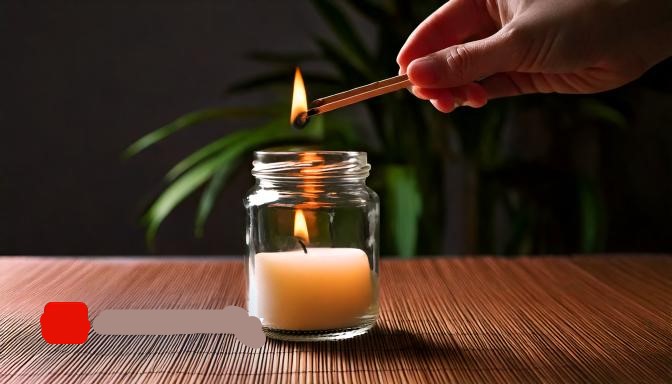
Preventing Future Incidents for Left Candle Burning in Glass Jar
Left candle burning in glass jar safely is crucial. Preventive steps help enjoy their ambiance without risks. Follow these strategies to ensure safety when using candles in glass jars.
Use Timers
Using timers is an effective way to prevent accidentally left candle burning in glass jar. Many flameless candles have built-in timers. These candles often have a switch at the bottom. When toggled, a timer activates. The candle stays on for a set time, like five hours. Then it automatically turns off for 19 hours. This 24-hour cycle ensures the candle only burns for a safe duration daily.
For traditional candles, set a separate timer or alarm. This reminds you to extinguish the flame. A simple step, but it reduces forgetting about burning candles.
Create a Safety Checklist
A candle safety checklist is an effective method to prevent incidents. Include essential safety practices like:
- Trim wick to 1/4 inch before use
- Keep candles away from drafts, vents
- Use stable, heat-resistant surface
- Extinguish when leaving room or sleeping
- Never burn candles over four hours
- Keep candles from children, pets
Using a checklist consistently helps people reduce risks of accidents with candles. It ensures no one left candle burning in glass jar.
Using Smart Home Devices
Smart home tech gives cool ways to boost candle safety. These devices can stop situations where someone may accidentally left candle burning all night at home. Some choices include:
- Smart smoke alarms send smartphone alerts if detecting smoke, allowing fast action even when away.
- Smart outlets power down at set times, useful for electric wax warmers or plug-in fragrance devices.
- Smart lighting mimics occupancy when homeowners are gone, reducing need for candles as ambient light sources.
Adding these smart devices to a home safety plan provides an extra safeguard against candle-related incidents. The tech offers convenience in managing lighting, fragrance sans open flame risks.
Although preventive steps are effective, extinguishing candles before leaving a room or sleeping is safest. Following strategies like these with vigilant candle use significantly reduces risks of accidents involving left candle burning in glass jar.
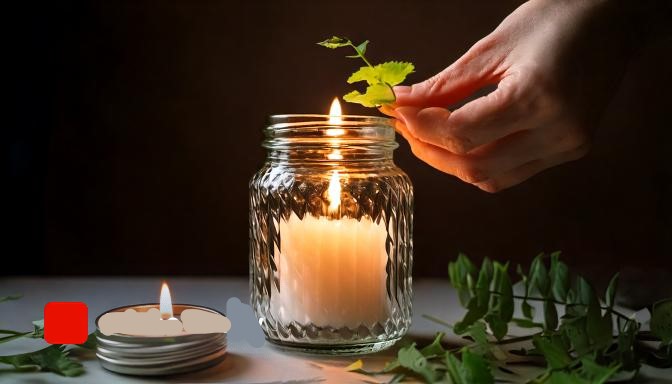
Choosing Safer Alternatives
For those concerned about accidentally left candle burning in glass jar. Fortunately, safer alternatives exist, delivering comparable ambiance and fragrance without open flames.
Flameless Candles
Flameless candles have grown popular, providing the look of real ones safely. With batteries powering flickering LED lights encased in wax shells, these mimic genuine candles astoundingly. Indistinguishable from traditional kin at a glance.
Longevity marks flameless candles’ key perk: a single battery set can supply over 500 hours of luminance! Cost-effective long-term, these faux candles often feature remotes controlling brightness, timers automatically shutting them off. This feature is particularly useful for those who worry about left candle burning in glass jar at home.
Essential Oil Diffusers
Essential oil diffusers comprise another safe choice for scenting spaces minus flames. Via varied mechanisms, these disperse essential oils aerially, perfuming surroundings pleasantly without fire risks. Prevalent diffuser styles include:
- Ultrasonic diffusers emitting micro-oil droplets misted from vibrating water reservoirs.
- Nebulizing diffusers are devices releasing essential oil mist without water or heat.
- Evaporative diffusers utilize fans to evaporate oil-soaked pad or filter into the air.
Essential oil diffusers provide safer scent options than candles, also offering potential health advantages. Many oils are known to reduce stress, improve sleep quality, and support sinus clearing.
Wax Warmers
Wax warmers offer flameless way to enjoy candle fragrance. These utilize low-heat sources like light bulbs or heating plates to melt scented wax. The melted wax releases aroma into air, creating pleasant scent without open flame.
Wax warmers have several benefits over traditional candles:
- Safety: Without an open flame, there’s no risk of accidentally left candle burning all night.
- Longer-lasting scent: Lower heat allows fragrance to linger longer than candles.
- Cost-effectiveness: Wax melts typically outlast candles, proving more economical long-term.
By choosing these safer alternatives, individuals can enjoy the ambiance and fragrance they love without the worry of left candle burning in glass jar at home. Whether flameless candles, essential oil diffusers, or wax warmers, these options provide peace of mind while creating warm, inviting atmosphere anywhere.
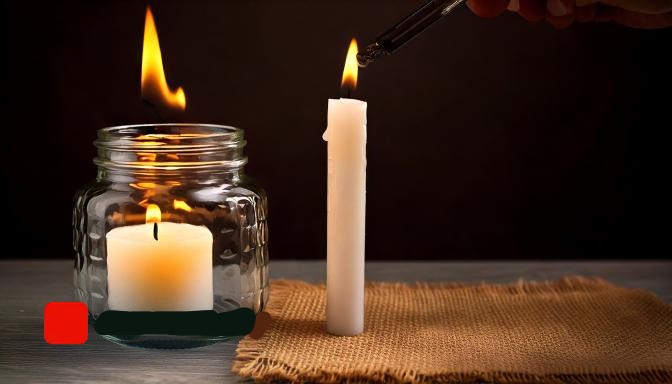
Dealing with Potential Consequences
Fire Damage
A blazing inferno, ignited by left candle burning in glass jar, can unleash catastrophic consequences. Fire’s destructive force ravages homes, consuming cherished possessions and undermining structural integrity. In the wake of such devastation, homeowners confront the daunting task of extensive restorations and renovations. Alarmingly, U.S. fire departments respond to an estimated 5,910 residential fires annually, sparked by candles. These infernos claim an average of 74 lives and inflict injuries upon 558 civilians each year.
When fire strikes, swift action is paramount. First, ensure the area is secure, the flames extinguished. Next, assess the scope of destruction, then promptly notify your insurance provider. Meticulously document the ravages through photographs and videos as evidence for claims. However, fire’s insidious reach often extends unseen, weakening hidden structures, compounding the visible wreckage.
Smoke and Soot Cleanup
Even a small candle lit at home can cause smoke and soot damage if left burning. Soot particles, also called char or carbon residue, remain after fires. These acidic particles cling to walls, leaving discoloration and an oily residue.
Cleaning smoke and soot requires special methods and equipment. For minor incidents like left candle burning in glass jar overnight, homeowners may handle cleanup themselves. However, for extensive damage, professional restoration services with expertise and proper equipment are best to safely and effectively remove soot.
When cleaning, wear protective gear like gloves, a face mask, and clothes covering skin. Ventilate the area well to minimize inhaling soot particles and dissipate smoke odors. Use a HEPA filter vacuum cleaner to safely remove soot from surfaces. For walls, use a dry-cleaning sponge to remove soot residue, working downwards to avoid spreading soot.
Insurance Considerations
When a candle-related incident occurs, dealing with the aftermath can be challenging. Insurance policies can provide financial assistance, but it’s crucial to understand that not all homeowners’ insurance automatically covers damage caused by candles. Some policies may exclude or limit coverage for fire damage resulting from negligence, such as leaving a candle burning without supervision.
Before any incident takes place, it’s wise to review your insurance policy thoroughly to comprehend the extent of your coverage. If you’re involved in the candle-making or selling business, some insurers offer specialized candle business insurance. This type of coverage can shield you from product liability claims and property damage related to candle usage, providing added protection for your business operations.
In the event that you suffer damage due to left candle burning in glass jar, it’s imperative to contact your insurance provider promptly. Document all damage meticulously, preserving receipts for any expenses incurred during cleanup or temporary housing arrangements. Be prepared to provide a detailed account of the incident, including any safety measures you had implemented.
Conclusion
Candles burning in glass jars require attentiveness, quick actions, and safety measures. This guide explores candle risks, steps for handling unattended flames, extinguishing methods and prevention tactics. It discusses safer alternatives to traditional candles. Understanding these points allows enjoying candle ambiance while reducing hazards.
Leaving candles burning overnight risks fire damage, smoke and soot cleanup. This content provides insights on addressing these outcomes, including insurance considerations. By following guidelines and vigilance, you can create a safer candle environment at home. Remember, extinguishing candles before leaving or sleeping ensures warmth and invitation without jeopardizing safety.
FAQs
What are the consequences of leaving a candle burning in a jar for an extended period?
When a candle remains lit in a jar for about four hours or more, carbon accumulates, leading to an unstable and potentially dangerous flame. This can cause the wax to tunnel, produce soot, damage the candle container, and increase the risk of the candle being accidentally knocked over.
What should I do if I accidentally left a candle burning?
It is important not to exceed the burn time recommended by the candle’s manufacturer. Overburning can cause the wick to collect carbon and “mushroom,” creating an unstable and large flame. This can also lead to the candle smoking and releasing soot.
How can I safely remove a candle from a glass jar?
To remove a candle from a glass jar, boil water and carefully pour the hot water into the jar, filling it only halfway. This allows the wax to float to the surface. Wait until the water cools down, then remove the solidified wax and clean the jar.
What occurs if a glass jar is left covering a burning candle?
If a glass jar covers a burning candle, the oxygen inside the jar gets consumed and is replaced by carbon dioxide, which does not support combustion. As a result, the candle will extinguish once all the oxygen is depleted.

Leave a Reply